The Posterior Walking Splint is an acceptable alternative to the Total Contact Cast and may be preferred over casting in the event of hypotrophic skin, active infection or poor circulation. The splint provides pressure relief similar to the cast. The splint may be advisable for use on patients who are extremely fearful of confinement or who have experienced secondary injury from casting. The walking splint provides an alternative to clinicians who are inexperienced with casting techniques or reluctant to use a cast. The splint may also be used, with appropriate modifications in padding, for the treatment of lesions on nonplantar areas of the foot and ankle. An appealing feature of the splint is the ease with which it may be removed. However, this may be a clear disadvantage for non-compliant patients, who may inappropriately remove the device and walk on the unprotected foot.

Indications:
- Plantar ulcerations in the presence of insensitivity
- Rigid post-operative dressing or immobilization device
- Interim footwear
- Patient for whom casts are determined inappropriate
Contraindications:
- Patient with poor balance
- Excessive swelling
Advantages:
- Removable/reusable
- Durable
- Lightweight
- Allows daily dressing changes
Disadvantages:
- Can be removed
- Does not immobilize the foot as well as a total contact cast